Light guidance
The light guidance defines the position lights of watercraft that they must guide between sunset and sunrise. If the visibility demands it, this light guidance must also be set in the time from sunrise to sunset. The road users show on-board lights in a certain arrangement, color and, in special cases, light phenomena such as sparkling lights .
In certain cases, it is also mandatory to carry so-called signal bodies during the day. Because they serve similar purposes as the lights, they are also listed in this article.
The light guidance is important for navigation in shipping and primarily serves to prevent accidents . It has been the subject of legislation since ancient times, first in the Rhodian Sea Law of 740, which prescribed a white light to mark ships at anchor at night. The International Naval Conference in Washington in 1889 tried to standardize the lighting around the world. There, the 27 participating states decided on an improved order of the sea. Germany put it into effect as an ordinance to prevent ships from colliding at sea of May 9, 1897 and as an ordinance on lights and signaling of fishing vessels and pilot steamers of May 10, 1897.
The light guidance has been anchored internationally in the collision avoidance rules (KVR) since 1972 and is confirmed in Germany by the shipping routes regulations.
Types of lights
The lighting of the vehicles is internationally standardized and is laid down in the 1972 International Rules for the Prevention of Collisions at Sea (Collision Prevention Rules , KVR). The following types of lights are defined:
Top light
The masthead light or steamer light is a white light shining forward. It must be visible over the longitudinal axis of the vehicle over an arc of the horizon of 225 °, 112.5 ° to each side. Since the masthead light is only shown by ships that are under engine, it is also known as a steamer light .
Sidelight
The sidelight designates the two sides of the ship: a red sidelight on port and a green sidelight on starboard , which must be visible 112.5 ° to each side.
Stern light
The stern light is a white light that shines backwards and must be attached as close as possible to the stern of the ship. It must appear on an arc of the horizon of 135 °, 67.5 ° to each side.
Position lights
Side lights, rear lights and masthead lights are collectively referred to as position lights in the narrower sense.
Tow light
The yellow towing light corresponds to a rear light and is also shown on the tractor with an attachment above the rear light. It must appear on an arc of the horizon of 135 °, 67.5 ° to each side.
All-round light
The all-round light is visible over the entire horizon arc 360 °.
Twinkle light
The sparkling light is a flashing light with at least 120 flashes per minute. Like all-round lights, sparkling lights are always visible over the entire horizon arc 360 °.
More lights
The use of additional lights is only permitted if, on the one hand, they cannot be confused with the prescribed lights in accordance with the collision prevention rules and, on the other hand, they do not dazzle the lookout. Also avoid dazzling the skippers of other ships. The use of spotlights must be restricted to the bare minimum.
Other lights can be: searchlights, stern lights for trawlers and fishermen, deck lights, loading lights, crane lights, etc. The cabin lighting, the lighting of the salon and work rooms also shine outwards.
Purpose of the lighting
The light guidance allows (partially limited) conclusions to be drawn
- what the direction of travel of another vehicle is,
- how long it is
- how it is powered (machine driven or not machine driven, which is relevant to right of way),
- whether the vehicle is in motion or whether it is sitting on the ground or at anchor,
- whether it drives through the water ,
- whether the vehicle is disabled or unable to maneuver and
- what type of use the vehicle is (e.g. use as a fishing vessel, pilot vehicle, mine clearer).
Strength of lights
The prescribed light intensity of the individual lights depends on the size of the vehicle. The light intensity is defined by the range of the lights, i.e. from what distance the lights must be recognizable under average visibility conditions.
- On vehicles 50 and more meters in length:
- Masthead light, 6 nautical miles
- Sidelights, 3 nautical miles
- Stern light 3 nautical miles
- Tow light, 3 nautical miles
- white, red, green or yellow all-round lights, 3 nautical miles.
- On vehicles of 12 and more but less than 50 meters in length:
- Masthead light, 5 nautical miles; on vehicles less than 20 meters in length, 3 nautical miles
- Sidelights, 2 nautical miles
- Stern light, 2 nautical miles
- Towing light, 2 nautical miles
- white, red, green or yellow all-round lights, 2 nautical miles.
- On vehicles less than 12 meters in length:
- Masthead light, 2 nautical miles
- Sidelights, 1 nautical mile
- Stern light, 2 nautical miles
- Towing light, 2 nautical miles
- white, red, green or yellow all-round lights, 2 nautical miles.
- On hard-to-see, partially submerged vehicles or objects that are being towed:
- white all-round light, 3 nautical miles.
For the technical design of the position lights, see main article Position light .
Light guidance and signal body at sea
A vehicle is considered to be in motion if it is "neither at anchor, moored on land, nor sitting aground." According to this regulation, a driving vehicle is a vehicle in motion and must have the prescribed lights (and, if necessary, in accordance with the collision prevention rules evade). However, some rules explicitly state that the lights only apply when the vehicle is driving through the water .
The international regulations can be supplemented nationally by further regulations. B. by the Maritime Traffic Regulations (SeeSchStrO). The numbers in square brackets reflect the corresponding rules of the KVR.
| designation | image | Remarks |
|---|---|---|
| General lighting guidance of machine vehicles | ||
| Machine vehicle in motion; From a length of 50 m, the 2nd masthead light is mandatory |  |
[23] General rule for machine vehicles: one masthead light in front, a second masthead light (more aft and higher than the first), side lights, one rear light |
| Machine vehicle in motion, shorter than 50 m | 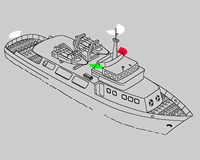 |
[23aII] The aft masthead light can be dispensed with under fifty meters in length. |
| Machine vehicle in motion, shorter than 20 m |  |
[21b] If the ship is less than 20 m long, the sidelights may be placed in a two-color lantern above the longitudinal axis. [23dI] If the ship is less than 12 m long, the masthead light and stern light may be combined in one all-round light. |
| Machine vehicle in motion, shorter than 7 m |  |
[23dII] A machine vehicle less than 7 m in length and whose maximum speed does not exceed 7 kn may have a white all-round light instead of top, rear and side lights and, if possible, must also have side lights. |
| Light guidance for non-motorized ships and boats | ||
| Sailing vehicle in motion |
 or 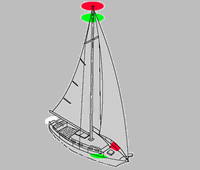
|
[25a] Sailing ships under sails have sidelights and a stern light, but no masthead light. Sailing vehicles that drive under a motor are considered machine vehicles and accordingly also have a masthead light - this is important because sailing vehicles have right of way over most machine vehicles. [25c] Sailing vehicles may also have two all-round lights vertically above one another at or near the top of the mast (the upper one red, the lower one green); Annex I No. 2 letter i KVR regulates: 2 m distance for vehicles over 20 m in length; 1 m distance for vehicles less than 20 m in length. However, these two additional lights must not be used together with the three-color lantern. |
| Sailing vehicle in motion, shorter than 20 m | 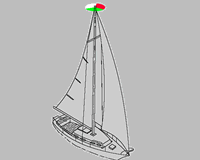 |
[25b] Sailing vehicles that are shorter than 20 m may have side and stern lights combined in a three-color lantern on the mast top. This enables sailors to reduce their power consumption. |
| Sailing vehicle in motion, with engine assistance during the day |  |
[25e] Sailing vehicles that drive with set sails under engine show a cone pointing downwards on the foredeck. |
| Sailing vehicle under 7 m |  |
[25d] Sailing craft less than 7 m in length must have the usual lights if possible, otherwise they must have a white hand lamp ready to hand and point it out if necessary. |
| Rowboat |  |
[25d] The same rules apply to rowing boats as to sailing boats under 7 m. |
| Towing associations | ||
| Towing vehicles |
 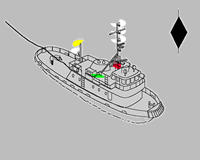
|
[24a] Towing vehicles have, in addition to the normal position lights, two masthead lights one above the other and one towing light above the rear light. If the towing convoy is longer than 200 m from the stern of the tug to the end of the attachment, three mast lights are led vertically one above the other.
[24a (v)] If the tow is longer than 200 m, a rhombus-shaped signal body must be guided where it can best be seen. [24h and i] Ships that are usually not used for towing do not need to have towing lights if this is not possible for them with reasonable effort. This also applies to cases in which ships have to be towed out of an emergency. In such cases, an attempt should be made to illuminate the towed vehicle or towline as well as possible. |
| Towed vehicles |
 
|
[24e] The towed vehicle or device has side and rear lights, but no masthead light.
[24 (viii)] If the tow is longer than 200 m, a rhombus-shaped signal body must be guided where it can be best seen. |
| Lights for signaling obstructions to maneuvering | ||
| Fishing trawlers ( i.e. vehicles that haul a trawl or other gear through the water) |  |
[26b] In addition to the usual lights for machine vehicles, a green all-round light is guided over a white. The position lights are omitted without driving through the water. The hourglass must be kept during the day. |
| Fishing vehicles that do not sail |  |
[26c] Only a red light is led over a white all-round light. When driving through the water, the position lights and the stern light are also available. The hourglass must be kept during the day.
When fishing gear is deployed that extends horizontally more than 150 meters into the water, a white all-round light - during the day a cone with an upward point - must be directed towards the fishing gear. |
| Unmaneuverable vehicle |
 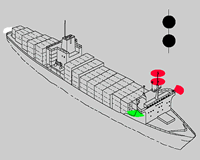
|
[27a] Two red lights on top of each other. Side lights and stern lights (but no masthead lights) only when the vehicle is driving through the water, i.e. not drifting. Other ships have to avoid ships that are unable to maneuver. During the day, disabled vehicles pass two balls on top of each other. The indication of inability to maneuver is not a distress signal. |
| Vehicle handicapped to maneuver, a "vehicle that is handicapped by the nature of its use, as prescribed by these rules and therefore cannot avoid another vehicle" (except mine clearing) | 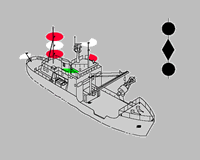 |
[27b] Three all-round lights (red - white - red one above the other), when driving through the water, the usual lights (side and top lights). During the day: a ball over a rhombus, with a ball underneath. These signals can be set, for example, when a large ship is moving in narrow fairways and its ability to navigate and comply with the rules of evasion is impaired as a result. Other ships evade. |
| A vehicle with impaired maneuverability that is dredging or performing underwater work |  |
[27d] Three all-round lights, red-white-red, mounted vertically on top of each other, of a maneuvering vehicle; In addition, two green all-round lights vertically on top of each other on the side on which the vehicle can be passed, and two red all-round lights vertically on top of each other on the side on which this is not possible (e.g. due to equipment protruding into the water). If it is possible to pass on both sides, the 2 green all-round lights are shown vertically one above the other on both sides. In this case, the vehicle must be passed on the right in the direction of travel (the latter only applies in fairways within the scope of the SeeSchStrO). |
| Vehicle performing diving work which cannot have all the prescribed lights |
 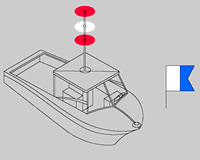
|
[27e] On the day: letter "A" of the international flag alphabet , at night additionally red-white-red. |
| Mine clearers in motion |  |
[27f] Three green lights arranged in a triangle and three balls arranged in a triangle. Other vehicles keep a distance of at least 1000 m. |
| Vehicle with restricted draft |  |
[28] Vehicles that can only move to a limited extent due to their draft put three red lights on top of each other or a cylinder.
Special feature: As soon as a ship that is draft-impaired according to the KVR enters the German territorial sea (12 nm zone seaward of the baseline), it is no longer considered draft-impaired, but instead as a so-called right-of-way vessel and is automatically classified as maneuvering impeded. |
| Pilot vehicle in the pilotage service |  |
[29] In addition to the usual lights as machine vehicles, vehicles in the pilotage service show a white over a red all-round light. |
| Ships without a voyage | ||
| Anchor berth | 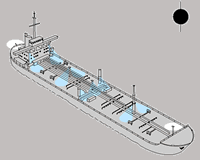 |
[30a] A ship at anchor sets two white all-round lights, one near the bow and one near the stern and under the forward light. During the day, the ship sets a black ball. Ships longer than 100 m must also have deck lights switched on. |
| Anchor berth under fifty meters |
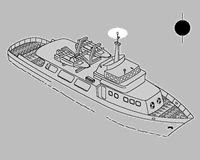 
|
[30b] Under fifty meters in length, a white all-round light is sufficient, during the day a ball. Ships under 7 m in length that anchor outside of narrow passages or fairways do not need to show any lights. The anchor light of sailboats is usually on the top of the mast. |
| Vehicle sitting on the ground |  |
[30d] Only vehicles over 12 m in length: Two red lights on top of each other, in addition to the anchor lights. Three black balls are raised every day. |
Inland shipping
The use of lights on inland waterways is regulated nationally, but in Germany, Austria and Switzerland largely corresponds to the international regulations, which are only supplemented by a few simplifications or special cases. For Germany, the relevant rules are set out in the Inland Waterways Ordinance (BinSchStrO). For international waters such as B. Lake Constance , special ordinances also apply ( Lake Constance shipping regulations ).
The following additions are common:
- Authorities vehicles in use (police, sea rescue, oil brigade, etc.): Blue sparkling light in addition to the navigation lights.
- A working device shows two green, bright or ordinary all-round lights on the side free for the passage, and a red all-round light on the blocked side
- Stuck or sunken ships show red and white all-round light and a red all-round light on the free side, where passage is prohibited.
- Vehicles that are unable to maneuver show a red light, pivoted in the lower semicircle.
- A ferry that is not moving freely shows a white all-round light 5 m above the depression mark and a green all-round light 1 m above it.
- Floating body or floating system: sufficient number of white all-round lights visible from all sides to make the outlines recognizable.
literature
- Seamanship. Yachting manual. Delius Klasing Verlag , Bielefeld 2008, ISBN 978-3-7688-0523-0 .
See also
Individual evidence
- ^ Law of the Sea Meyers Großes Konversations-Lexikon, Volume 18. Leipzig 1909, pp. 268–269. zeno.org, accessed on May 31, 2020.
- ↑ Alfred Lübke: The historical development of the light guidance in sea road traffic The Seewart. Nautical magazine for German shipping 1957, pp. 95-105.
- ↑ a b c d International rules from 1972 for the prevention of collisions at sea www.gesetze-im-internet.de. Retrieved September 21, 2012.
- ↑ § 6 Visual and sound signals from the vehicles. (No longer available online.) Archived from the original on June 21, 2016 ; accessed on June 21, 2016 . Info: The archive link was inserted automatically and has not yet been checked. Please check the original and archive link according to the instructions and then remove this notice.

